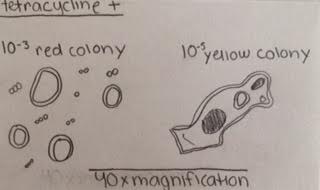User:Anisa Santiago/Notebook/Biology 210 at AU
Exercise 3, Microbiology and Identifying Bacteria
Before the procedures for Exercise 3 were conducted, one last observation of the Hay Infusion for Transect 4 was made. Similar to the previous week, the Hay Infusion Culture had not changed that much. The water, however, was slightly darker and the white film that was layering the top of the water had browned slightly. I would hypothesize that if the Hay Infusion Culture would be left to sit from week to week then we would see a change in the amount of algae and bacteria growing on the top of the water, along with a change in the color of the water due to the opportunity the contents in the container have to dissolve into the water.
Quantifying and Observing Microorganisms
Table 1: 100-fold Serial Dilutions Results

The data shown in Table 1 was collected after observing the growth of bacteria on the eight agar plates inoculated from the Hay Infusion Culture that were prepared the previous week. It can be seen that more colonies of bacteria formed on the agar plates that just contained nutrient agar compared to the plates that contained nutrients and tetracycline. This can be because of the fact that tetracycline is an antibiotic meaning that the agar plates containing the tetracycline did not offer a hospitable environment for bacteria to grow. The few colonies that had grown on the agar plates containing tetracycline were probably resistant to the antibiotic, allowing for it to survive on the agar plate. Tetracycline inhibits protein synthesis (Chopra)* however some bacteria, such as staphylococcal, streptococcal, and pneumococcal, are typically resistant to tetracycline(Klajn)*.
Bacteria Cell Morphology Observation
In order to observe the bacteria cell morphology, two well defined colonies from the nutrient agar plate and two from the tetracycline plate were chosen. These four colonies were used to perform a gram stain and a native wet mount. Table 2 depicts the characteristics of each of the four chosen bacterial colonies recorded after performing the Gram Stain and the native wet mount. The images following Table 2 are the drawings of each organism observed from the four bacterial colonies chosen.
- Sources:
Chopra, Ian, and Marilyn Roberts. "Tetracycline Antibiotics: Mode of Action, Applications, Molecular Biology, and Epidemiology of Bacterial Resistance." Microbiology and Molecular Biology Reviews. American Society for Microbiology, June 2001. Web. 31 Jan 2016. <http://www.ncbi.nlm.nih.gov/pmc/articles/PMC99026/>.
Klajn, Rafal. "Antimicrobial Properties." Tetracycline. Institute of Organic Chemistry, n.d. Web. 31 Jan. 2016. <http://www.chm.bris.ac.uk/motm/tetracycline/antimicr.htm>.
Exercise 2, Identifying Algae and Protists
The following data was recorded after observing the Hay Infusion Culture for Transect 4
The appearance of the culture was that of dirty, murky water. It smelled of decomposing feces and had a white film-like mold on the surface of the water, indicating apparent life.
Organisms from Niche 1: Area near plant and mold, on the surface of the water
Organisms from Niche 2: Bottom of the container near flower petal
If the culture grew for another two months, I would expect to see a large, more profound amount of mold and green shoots, not only on the surface of the water, but throughout the entire culture. I would expect that over the course of the two months, the organisms already living in the culture that rely on consuming nutrients would use up all their resources and would probably begin to die. On the other hand, those organisms that produce their own nutrients, would continue to grow and reproduce.
Exercise 1, Examining Biological Life at AU: Transect Report
General Characteristics of Transect
The Transect being observed is Transect 4. Transect 4 is located outside of Gray Hall, behind SIS and the Library. The specified 20 by 20 foot area is a part of a quiet, wildlife observation area. There are two wooden benches where passerby's can in front of a small pond. The area is decorated with 3 trees and several bushes with pink flowers. The pond in the center of the designated transect area is bordered with various size rocks and two small decorative statues. The two benches are in front of the pond, facing inwards towards each other. The day of observation was sunny and frigid.
Ariel View of Transect
Key for Areal Diagram
- 1. Benches
- 2. Pond
- 3. Rocks Surrounding Pond
- 4. Stone Pathway
- 5. Tree
- 6. Flower Bushes
- 7. Weed Grass
- 8. Twig Bushes
- 9. Grass
Components of Transect
Biotic Numbers in parenthesis indicate drawn location of components within the transect
- Trees (5)
- Flower Bush (6)
- Twig Bush (8)
- Grass (9)
- Fish (in pond)
- Water (in pond 2)
Abiotic Numbers in parenthesis indicate drawn location of components within the transect
- Soil (dispersed throughout the transect)
- Acorns (dispersed throughout the transect)
- Dead Leaves (dispersed throughout the transect)
- Rocks (3)
- Stones (4)
- Benches (1)
- Garden Statue (Located on the south corner of the pond)
- Wildlife Observation Sign (Past furthest tree on the SE side of transect)
Photographs of Different Areas in the Transect
- West corner of transect. Tree and Flower Bush shown.
- Pond and rocks surrounding pond
- Grass Patch in Transect
- Stone Pathway
- South Corner of Transect. Tree shown.
- Flower Bush shown














